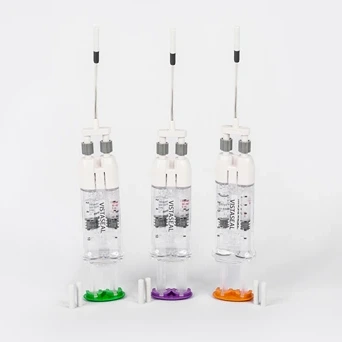Key Messages
- 30% of lung resection patients present with three or more comorbidities.1 which increases the risk of postoperative bleeding, transfusion-related complications, and procedural inefficiencies.
- VISTASEAL™, is composed of human thrombin and fibrinogen, which forms a rapid, adherent, and durable clot forms a rapid, adherent, and durable clot on targeted tissue regardless of the patient’s coagulation profile.2-4
- VISTASEAL™ conforms to the tissue surface and provides immediate hemostasis with minimal manipulation.
- VISTASEAL™ is fast to set up with pre-filled syringes and no warming required.5
- The flexible dual applicator also provides enhanced access to difficult anatomy.
Detailed Talk Track
Doctor, I noticed you opted for suture-based control when addressing bleeding in this high-risk patient. In many cases, especially involving patients with comorbidities or friable tissue, traditional methods like suturing can be time-consuming, technically demanding, and may cause additional tissue trauma.
In fact, retrospective data shows that over 30% of lung resection patients present with three or more comorbidities.¹ These patients often have compromised coagulation profiles, making reliable hemostasis more difficult and increasing the risk of postoperative bleeding, transfusion-related complications, and procedural inefficiencies.
I’d like to introduce you to VISTASEAL™, a fibrin sealant composed of human thrombin and fibrinogen, which forms a rapid, adherent, and durable clot forms a rapid, adherent, and durable clot on targeted tissue regardless of the patient’s coagulation profile.²⁻⁴ Unlike suturing, which requires tissue integrity and manual precision, VISTASEAL™ conforms to the tissue surface and provides immediate hemostasis with minimal manipulation.
Operationally, VISTASEAL™ is fast to set up with pre-filled syringes and no warming required, allowing you to address bleeding quickly and confidently.⁵ The flexible dual applicator also provides enhanced access to difficult anatomy—such as within the thoracic cavity—without needing to re-position instruments or retract fragile structures.
Given the clinical and procedural advantages, would you be open to evaluating VISTASEAL™ in your next few high-risk or anticoagulated patients to experience the difference in efficiency and performance compared to suturing?
References
1. Danker W. Increasing Incremental Burden of Surgical Bleeding Associated with Multiple Comorbidities as Measured by the Elixhauser Comorbidity Index: A Retrospective Database Analysis. Society for the Advancement of Patient Blood Management, September 16, 2022. Ethicon, Inc.
2. Bjelovic M, Ayguasonosa J, Kim RD, et al. A prospective, randomized, phase III study to evaluate the efficacy and safety of fibrin sealant Grifols as an adjunct to hemostasis as compared to cellulose sheets in hepatic surgery resections. J Gastrointest Surg. 2018. 22:1939–1949.
3. Nenezic D, Ayguasonosa J, Menyhei G, et al. A prospective, single-blind, randomized, phase III study to evaluate the safety and efficacy of Fibrin Sealant Grifols as an adjunct to hemostasis compared with manual compression in vascular surgery. J Vasc Surg. 2019: doi.org_10.1016_j.jvs.2018.12.051.
4. Lakshman S, Aqua K, Stefanovic A, et al. A prospective, single blind, randomized, phase III study to evaluate and efficacy of fibrin sealant Grifols as an adjunct to hemostasis during soft tissue open surgery. J Invest Surg. 2018;DOI:10.1080_08941939.2018.1489917.
5. Chetter I, Stansby G, Sarralde JA, et al. A prospective, randomized, multicenter clinical trial on the safety and efficacy of a ready-to-use fibrin sealant as an adjunct to hemostasis during vascular surgery. Ann Vasc Surg. 2017;45:127–137.
CONFIDENTIAL. FOR INTERNAL USE ONLY. NOT FOR USE WITH ANY CUSTOMER OR FOR EXTERNAL DISTRIBUTION.
Close
